Abstract
Objectives:
To determine the proportion of geriatric depression and factors associated with its occurrence among a sample of the elderly population in Sohag Governorate.
Methods:
A cross-sectional, community-based study was conducted from May 2016 to March 2017 with 1,027 elderly individuals (aged ≥60 years) living in Sohag Governorate, Egypt. A questionnaire was designed and included inquiries on socio-demographic variables (age, gender, and residence) and the 15-item Geriatric Depression Scale (GDS-15) to determine the outcome variable, the presence of depression, among the studied elderly population.
Results:
About two-thirds (62.7%) of participants suffered from depression. Regarding depression levels, 450 (43.8%) participants had mild depression with GDS-15 scores between 5 and 8, and 18.9% of participants had moderate depression, represented by GDS-15 scores between 9 and 11. No participants had severe depression. Applying logistic regression analysis, increased age, female gender, and living in rural areas were significantly linked to the occurrence of geriatric depression among participants.
Conclusion:
These findings highlight the need to introduce geriatric clinics into healthcare services and to provide counseling and psychiatric services, and to support high-risk groups and evaluate them regularly for early detection in order to positively impact their life quality.
Aging is an inevitable occurrence, and advanced age is defined as the period in which people need help from others in most aspects of life.1 Accelerated population aging in most developed and developing countries resulting from prolonged lifespans is a grave concern for health services, especially mental health services.2 Among the world’s population, 12.3% were in the age group at or above 60 years in 2015, and by 2050, this percentage is expected to rise to 21.5%, with an increase to beyond 32.8% in more developed regions.3,4 In Egypt, old age is supposed to begin at age 60, and this group represents 7.2% of the population.5,6 The elderly population in Egypt is expected to rise by 10.9% by 2026.7 This increase in the number of elderly and age-related diseases will increase the need for healthcare services and social security.8 Moreover, elderly who are economically dependent often suffer from negligence. As a result, they are at risk of having developmental disorders, which are the subject of important interest worldwide.9 Depression is considered a major causes of decreased life quality and is the second main reason for disability.10 Additionally, it is considered a risk factor for cognitive impairment, which can seriously impact public health.11 The World Health Organization (WHO) determined that 350 million individuals had depression, while more than 800,000 individuals die from suicide yearly.12 Depression is mainly presented either by an absence of interest in all activities or a depressed mood. Moreover, depressed individuals may have decreased energy, difficulty thinking, lack of concentration, appetite or weight changes, suicide attempts, feelings of regret or uselessness, or repetitive self-destructive thoughts.13 The consequences of depression may encompass reduced life quality, dissatisfaction, social deprivation, loneliness, and cognitive decline.14 Studies have uncovered that depression is a frequent problem among the elderly, causing an increased disability risk among them.15 Recently, a meta-analysis showed that the prevalence of major depression among individuals 50 years old and above in Western countries was 16.5%.15 Another cohort study concluded that depression incidence rises with age.16 Several factors have been reported by WHO that could enhance the risk of depression among the elderly, including genetic factors, disability, pain, and chronic diseases.15 Additionally, other socio-economic factors have been linked with depression and sub-threshold depression, such as old age, female gender, low education, being unmarried or living alone, physical illness, and low cognitive function.17 Females are more liable to develop depression, especially in old age because they lose their traditional housewife role due to functional disabilities.18 Furthermore, they are often alone after the early loss of their husbands and as a consequence receive decreased support from family.19 Moreover, rural residents suffer from more morbidities and limited accessibility to healthcare services, especially when they are alone and often lack a regular income which may add to an increased probability of developing depression.1,19 Due to the lack of available information on depression among the elderly and the factors associated with its occurrence in our community, this study was conducted to determine the proportion of geriatric depression and factors associated with its occurrence among a sample of the elderly population in Sohag Governorate, Egypt.
Methods
Study design
The study was designed as a cross-sectional, community-based study conducted from May 2016 to March 2017 with a sample of elderly individuals (aged ≥ 60 years) living in Sohag Governorate.
Study settings and sampling technique
Sohag Governorate is located in the southern part of Egypt and has a total area of 11,022 km2 and an inhabited area of 1,547 km2 with an estimated 4.9 million inhabitants. The Governorate consists of 12 districts. Sohag city, the capital, is located 467 km south of Cairo.
A multi-stage sampling technique was used based on the districts of the Governorate. Four districts representing the 4 geographical regions (north, east, south, and west) of Sohag Governorate were selected by simple random sampling from the 12 districts of Sohag Governorate involved in the research. From each district, 2 regions were chosen randomly, representing both urban and rural zones in the selected districts. Houses were selected by systematic random sampling from the selected areas (every fifth house) to recruit the elderly to participate in the study. Houses with no elderly persons were ignored and the following houses were reviewed until a house with an elderly person was found, with this process continuing according to systematic random sampling from the last reviewed house.
Sample size
The sample size was calculated by OpenEpi program (Version 3.01, Open Source Epidemiologic Statistics for Public Health, USA)20 using the following assumptions: prevalence of geriatric depression as 38.7%, as reported by a previous study performed in El-Minia Governorate, power as 80%, and confidence interval set at 99.9%.21 Based on these assumptions, the sample size was calculated to be 1,027 participants.
Inclusion criteria
Elderly individuals (aged ≥ 60 years) who agreed to participate in the study after the purpose of the research was explained were included in the present study.
Exclusion criteria
Individuals were excluded if they could not speak or listen (i.e., were mute or deaf) or they suffered from a mental problem preventing them from understanding the questionnaire.
The number of participants selected from each district was proportionate to the population size of each district. The selected urban and rural areas chosen from each district are illustrated in Table 1.
Table 1.
Selected districts and the urban and rural areas chosen from each.
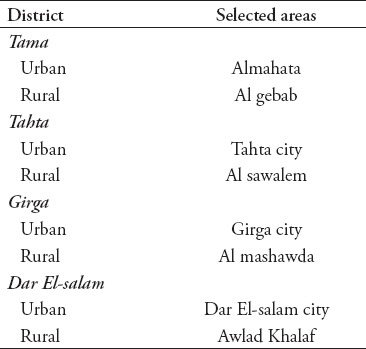
Data collection
Data were gathered through personal interviews with the elderly individuals who accepted to participate in the study after their informed consent was received. The designed questionnaire consisted of 2 parts: the first part included inquiries on socio-demographic variables (age, gender, and residence) and the second part was intended to determine the outcome variable, the presence of depression, which was assessed by means of the 15-item Geriatric Depression Scale (GDS-15).
The GDS-15, designed by Yesavage et al22 has frequently been used to detect depression among the elderly. It consists of 15 items that each can be answered either “yes” or “no.” The Arabic form of GDS-15 was used in this study.23
Data analysis and presentation
The Statistical Package for the Social Science Version 22 (IBM Corp., Armonk, NY, USA) was utilized for data entry and analysis. Categorical data were presented as numbers and percentages.24 A Chi-squared test was used for comparing qualitative variables. Associations between geriatric depression and the studied determinants were examined using binary logistic regression. A 5% level was chosen as the level of statistical significance.
As regards scoring of the GDS-15, the response to each item was either “yes” (scored 1) or “no” (scored 0) with a total score of 15. Individuals whose scores were less than 5 are considered normal; scores of 5–8 denote mild depression; scores of 9–11 indicate moderate depression; and scores of 12–15 indicate severe depression.
Ethical consideration
Approval of the Research Ethics Committee of Faculty of Medicine, Sohag University, was secured and informed consent was secured from all respondents after the purpose of the study was explained. The questionnaires used for information gathering were anonymous and data confidentiality was guaranteed.
Results
The present study included 1,027 participants, of whom 433 (42.2%) were in the age group from 60-69 years old and only 49 participants (4.8%) were 90 years old or older. Males represented 48% of the studied elderly population. Among participants, there were 516 rural residents (50.2%) (Table 2).
Table 2.
Socio-demographic characteristics of the study population (N=1,027).
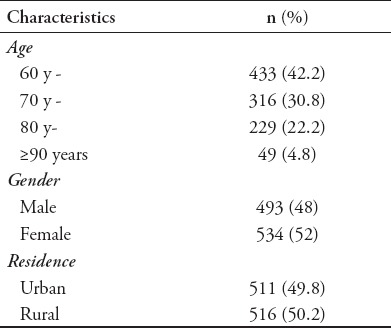
Figure 1 shows that 62.7% of participants suffered from depression. Regarding depression levels, 450 participants (43.8%) had mild depression with GDS-15 scores between 5 and 8, and those with moderate depression represented 18.9% of the total, with GDS-15 scores between 9 and 11. No participants had severe depression (Table 3).
Figure 1.
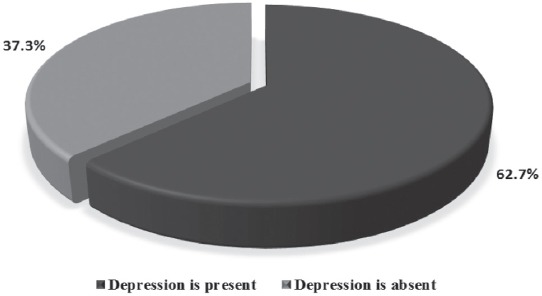
Depression among the studied elderly population (N=1,027)
Table 3.
Distribution of the studied elderly persons according to level of depression.

Table 4 shows that most participants (95.9%) in the age group 90 years old or above suffered from depression compared with 26.6% of participants younger than 70 years old (p-value<0.001). More than three-quarters of participating females (75.3%) suffered from depression compared with 49.1% of males. Concerning residence, 71.3% of the surveyed rural inhabitants had depression compared with 54% of urban residents. These differences were highly significant (p-value<0.001).
Table 4.
Sociodemographic variables and the presence of depression among participants (N=1,027).
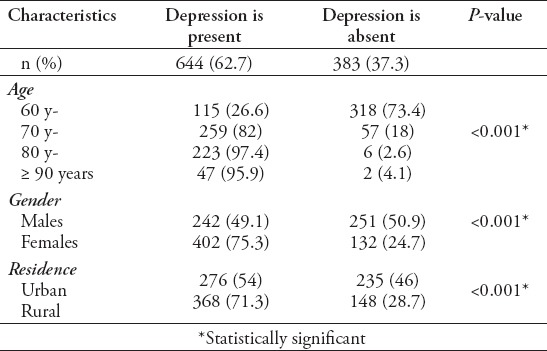
Logistic regression analysis recognized age, gender, and residence as significant predictor variables of geriatric depression. As is clear from the presented data, age had the highest odds ratio, which suggests that aging is most significantly linked to the occurrence of depression (p-value<0.001), followed by gender and residence (Table 5).
Table 5.
Logistic regression analysis of factors predicting depression among the studied population.
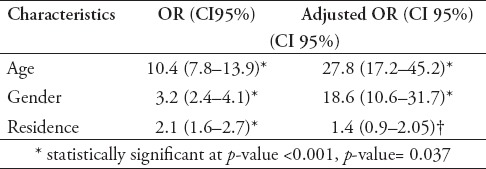
Discussion
Geriatric depression is a frequent health problem that is often not detected and mostly undertreated. The widespread nature of the disease, its adverse interactions with physical health, and the resulting disability necessitate the study of this disease and its related factors.8
The present study clarified that 62.7% of the participating elderly suffered from depression, which is close to the findings of many prior studies in Egypt exploring depression prevalence among the elderly population. For example, El-Sherbiny et al7 measured elderly depression prevalence and identified it as 74.5%, and in another study performed in Alexandria, 75% of the elderly population over 75 years old was found to suffer from depression.7,25 Likewise, the investigated depression prevalence of elderly individuals attending the Zagazig University Hospital in Egypt was 72%.26 Finally, a study done in Cairo by Al-Kholy et al exhibited that the estimated depression prevalence among elderly people visiting primary care clinics was 54.3%.27
However, our findings were lower than those outlined by Ahmed et al28 who found that 80% of those living in geriatric homes in Cairo suffered from depression, anxiety, or a mix of the two. This high frequency could be interpreted as being caused by inadequate social support and residing alone in a geriatric home, which represents a stressor not shared by those living with their family members.7
In Western countries, the estimated prevalence of elderly depression has been found to be 30.3% in Korea, 11.6% in China, 29.1 in Mexico, and 45.8% in Turkey.1,29-30,31 This difference might be due to using different cut-off points, and sometimes differences are the result of a different depression prevalence among different elderly populations.10
The high proportion of geriatric depression revealed by the present research and other studies performed in Egypt compared with the much lower rates in Western countries might be attributed to the harsh economic and living conditions faced by elderly people in Egypt, along with pensioners’ low income and the failure to provide health and social services which meet their health and psychological needs. Additionally, socio-cultural changes and methodological differences may play a role in this discrepancy.
As indicated by the present study, age, female gender, rural residence were strong predictor variables of elderly depression, which is consistent with the findings of El-Sherbiny et al7 and El Kady et al.25
In the present study, a significantly higher proportion of women suffered from depression compared with men (p<0.001), which agrees with the results of studies conducted in many countries.1,10,18,19,32 As a fact of life, the female sex has a high tendency to develop depression. For elderly women, the underlying reasons are being old, being women, and being poor; moreover, they are mostly deprived of family support, especially after an early loss of their spouses.18,19
Residing in a rural area was another depression predictor variable among the participants in our study, which is similar to the findings of studies done in rural China and India.18,33 This reflects rural residents’ greater health problems and more limited healthcare services due to poor accessibility and lack of regular income, which suggests that greater attention should be paid to mental health in rural areas, especially among those who live alone.33
In contrast to the findings in this study, no significant relation was found between age and depression among the participants in a study conducted by Sinha et al2 in India and a study done in China by Zhou et al.34 In addition, age and gender were not found to be significantly related to the development of depression in a study carried out by Pracheth et al.8 Another study by Prashanth et al15 found that gender was not significantly linked to geriatric depression. This may be explained by the small sample size (51 individuals) involved in the latter study, which may be inadequate for establishing actual gender differences.
Limitations of this study include that the causal relationship cannot be ascertained since the study was a cross-sectional survey; moreover, other factors that might be related to geriatric depression were not covered, such the impact of illness on quality of life.
In conclusion, the current study highlights the size of the problem of depression among the elderly population of Sohag Governorate and provides baseline information for further research in this area. It has been found that geriatric depression is prevalent among the studied sample of the elderly population in Sohag Governorate (62.7%), and older age, female gender, and rural residence are strong predictor variables of its occurrence. These findings necessitate the introduction of geriatric clinics within healthcare services and the provision of counseling and psychiatric services, along with support for high-risk groups and their regular evaluation for early detection to positively impact their life quality. Moreover, public awareness of mental problems among the elderly population and how to deal with them should be addressed and enhanced.
Footnotes
References
- 1.Arslantas D, Unsal A, Ozbabalik D. Prevalence of depression and associated risk factors among the elderly in Middle Anatolia, Turkey. Geriatr Gerontol Int. 2014;14:100–108. doi: 10.1111/ggi.12065. [DOI] [PubMed] [Google Scholar]
- 2.Sinha SP, Shrivastava SR, Ramasamy J. Depression in an older adult rural population in India. MEDICC rev. 2013;15:41–44. doi: 10.37757/MR2013V15.N4.10. [DOI] [PubMed] [Google Scholar]
- 3.United Nations. World Population Ageing 2015. Department of Economic and Social Affairs, Population Division. 2015 [Google Scholar]
- 4.Zis P, Daskalaki A, Bountouni I, Sykioti P, Varrassi G, Paladini A. Depression and chronic pain in the elderly: links and management challenges. Clin Interv Aging. 2017;12:709–720. doi: 10.2147/CIA.S113576. [DOI] [PMC free article] [PubMed] [Google Scholar]
- 5.Mostafa MHAT. The old people in Egypt, Case Study (Ismailia Governorate) Central Agency for Public Mobilization and Statistics, Cairo, Egypt. 2013. From: https://www.psychiatry.org/psychiatrists/practice/dsm .
- 6.CAPMAS - Central Agency for mobilization and Statistics. Egypt in Figures 2015. CAPMAS. 2015. from: https://article.wn.com/view/2015/03/02/Egypt_in_Figures_2015_CAPMAS_Central_Agency_for_mobilization/
- 7.El-Sherbiny NA, Younis A, Masoud M. A comprehensive assessment of the physical, nutritional, and psychological health status of the elderly populace in the Fayoum Governorate (Egypt) Arch Gerontol Geriatr. 2016;66:119–126. doi: 10.1016/j.archger.2016.06.001. [DOI] [PubMed] [Google Scholar]
- 8.Pracheth R, Mayur SS, Chowti JV. Geriatric depression scale: A tool to assess depression in elderly. Int J Med Sci Public Health. 2013;2:31–35. [Google Scholar]
- 9.Park JI, Park TW, Yang JC, Chung SK. Factors associated with depression among elderly Koreans: the role of chronic illness, subjective health status, and cognitive impairment. Psychogeriatrics. 2016;16:62–69. doi: 10.1111/psyg.12160. [DOI] [PubMed] [Google Scholar]
- 10.Taheri Tanjanai P, Moradinazar M, Najafi F. Prevalence of depression and related social and physical factors amongst the Iranian elderly population in 2012. Geriatr Gerontol Int. 2017;17:126–131. doi: 10.1111/ggi.12680. [DOI] [PubMed] [Google Scholar]
- 11.Pellegrino LD, Peters ME, Lyketsos CG, Marano CM. Depression in cognitive impairment. Curr Psychiatry Rep. 2013;15:384. doi: 10.1007/s11920-013-0384-1. [DOI] [PMC free article] [PubMed] [Google Scholar]
- 12.World Health Organization. Media Centre. Depression. Geneva (CH): 2016. From: https://www.psychiatry.org/psychiatrists/practice/dsm . [Google Scholar]
- 13.American Psychiatric Association. Diagnostic and statistical manual of mental disorders (DSM-5®) Arlington (VA): American Psychiatric Publishing; 2013. [Google Scholar]
- 14.McCall WV, Kintziger KW. Late life depression: a global problem with few resources. Psychiatr Clin North Am. 2013;36:475–481. doi: 10.1016/j.psc.2013.07.001. [DOI] [PMC free article] [PubMed] [Google Scholar]
- 15.Prashanth A, Rakesh MPK, Praveena V, Preethi A, Prithvi S, Priyadharshini R, et al. Prevalence of depression and factors influencing it among geriatric population attending the outpatient department of a tertiary care hospital. Advanced Medical Sciences: An International Journal (AMS) 2015;2:1–5. [Google Scholar]
- 16.Solhaug HI, Romuld EB, Romild U, Stordal E. Increased prevalence of depression in cohorts of the elderly: an 11-year follow-up in the general population - the HUNT study. Int psychogeriatr. 2012;24:151–158. doi: 10.1017/S1041610211001141. [DOI] [PubMed] [Google Scholar]
- 17.Vaccaro R, Borrelli P, Abbondanza S, Davin A, Polito L, Colombo M, et al. Subthreshold Depression and Clinically Significant Depression in an Italian Population of 70-74-Year-Olds: Prevalence and Association with Perceptions of Self. Biomed Res Int. 2017;2017:3592359. doi: 10.1155/2017/3592359. [DOI] [PMC free article] [PubMed] [Google Scholar]
- 18.Pilania M, Bairwa M, Khurana H, Kumar N. Prevalence and predictors of depression in community-dwelling elderly in rural Haryana, India. Indian J Community Med. 2017;42:13–18. doi: 10.4103/0970-0218.199792. [DOI] [PMC free article] [PubMed] [Google Scholar]
- 19.Maulik S, Dasgupta A. Depression and its determinants in the rural elderly of West Bengal—A cross sectional study. International Journal of Biological and Medical Research. 2012;3:1299–1302. [Google Scholar]
- 20.Dean AG, Sullivan KM, Soe MM. [[updated 2013 April; Accessed 2018 January]];OpenEpi: Open source epidemiologic statistics for public health, Version. www.OpenEpi.com. 2013 [Google Scholar]
- 21.Mahmoud MM, Abdel-Fadeel NAM, Hassan MA, Taha M, Elsherbiny AM, Saad Eldin AM, et al. Geriatric depression: prevalence, risk factors, and relationship to physical illnesses in a sample of medical clinic outpatients. Middle East Current Psychiatry. 2016;23:93–98. [Google Scholar]
- 22.Yesavage JA, Sheikh JI. 9/Geriatric Depression Scale (GDS) recent evidence and development of a shorter version. Clinical Gerontologist. 1986;5:165–173. [Google Scholar]
- 23.Chaaya M, Sibai AM, Roueiheb ZE, Chemaitelly H, Chahine LM, Al-Amin H, et al. Validation of the Arabic version of the short Geriatric Depression Scale (GDS-15) International psychogeriatrics. 2008;20:571–581. doi: 10.1017/S1041610208006741. [DOI] [PubMed] [Google Scholar]
- 24.IBM Corp. IBM SPSS Statistics for Windows, Version 22.0. Armonk, NY: IBM Corp; 2013. [Google Scholar]
- 25.El Kady H, Ibrahim H. Depression among a group of elders in Alexandria, Egypt/Depression dans un groupe d'anciens a Alexandrie (Egypte) Eastern Mediterranean Health Journal. 2013;19:167. [PubMed] [Google Scholar]
- 26.Esmayel EM, Eldarawy MM, Hassan MM, Mahmoud AA, Mohamed SY. Mental Health Problems and Sociodemographic Correlates in Elderly Medical Inpatients in a University Hospital in Egypt. Current Gerontology and Geriatrics Research. 2013;2013:4. doi: 10.1155/2013/923710. [DOI] [PMC free article] [PubMed] [Google Scholar]
- 27.Al-Kholy RS, El-Meshmeshy EI, Saleh AA. Prevalence of Geriatric Depression among Attendants of the Family Medicine Outpatient Clinics, in Kasr Al-Ainy, Faculty of Medicine: A Cross-Sectional Descriptive Study. Medical journal of Cairo University. 2016;84:97–106. [Google Scholar]
- 28.Ahmed D, El Shair IH, Taher E, Zyada F. Prevalence and predictors of depression and anxiety among the elderly population living in geriatric homes in Cairo, Egypt. J Egyptian Public Health Assoc. 2014;89:127–135. doi: 10.1097/01.EPX.0000455729.66131.49. [DOI] [PubMed] [Google Scholar]
- 29.Park JI, Park TW, Yang JC, Chung SK. Factors associated with depression among elderly Koreans: The role of chronic illness, subjective health status, and cognitive impairment. Psychogeriatrics. 2016;16:62–69. doi: 10.1111/psyg.12160. [DOI] [PubMed] [Google Scholar]
- 30.Li N, Chen G, Zeng P, Pang J, Gong H, Han Y, et al. Prevalence of depression and its associated factors among Chinese elderly people: A comparison study between community-based population and hospitalized population. Psychiatry Res. 2016;243:87–91. doi: 10.1016/j.psychres.2016.05.030. [DOI] [PubMed] [Google Scholar]
- 31.Ortiz GG, Arias-Merino ED, Flores-Saiffe ME, Velázquez-Brizuela IE, Macías-Islas MA, Pacheco-Moisés FP. Prevalence of Cognitive Impairment and Depression among a Population Aged over 60 Years in the Metropolitan Area of Guadalajara, Mexico. Curr Gerontol Geriatr Res. 2012;2012:175019. doi: 10.1155/2012/175019. [DOI] [PMC free article] [PubMed] [Google Scholar]
- 32.Mubeen SM, Henry D, Nazimuddin Qureshi S. Prevalence of depression among community dwelling elderly in karachi, pakistan. Iran J Psychiatry Behav Sci. 2012;6:84–90. [PMC free article] [PubMed] [Google Scholar]
- 33.He G, Xie JF, Zhou JD, Zhong ZQ, Qin CX, Ding SQ. Depression in left-behind elderly in rural China: Prevalence and associated factors. Geriatr Gerontol Int. 2016;16:638–643. doi: 10.1111/ggi.12518. [DOI] [PubMed] [Google Scholar]
- 34.Zhou X, Bi B, Zheng L, Li Z, Yang H, Song H, et al. The prevalence and risk factors for depression symptoms in a rural Chinese sample population. PloS One. 2014;9:e99692. doi: 10.1371/journal.pone.0099692. [DOI] [PMC free article] [PubMed] [Google Scholar]


